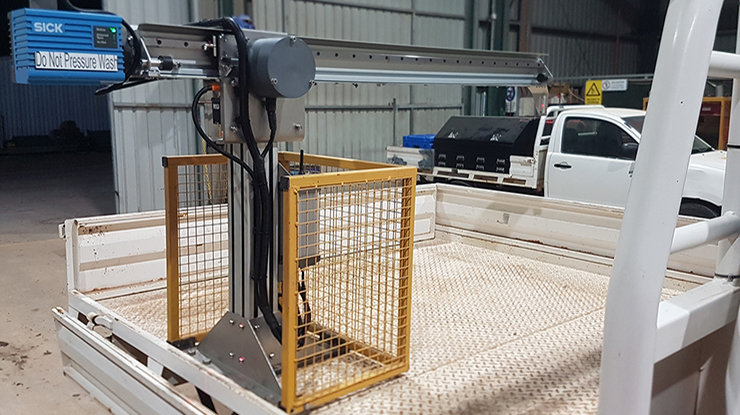 Automated bunk scanning in action at a feedlot. Image: Manabotix.
Automated bunk scanning in action at a feedlot. Image: Manabotix.
World first automated bunk management trial matches humans
A collaboration between Meat & Livestock Australia (MLA), Bovine Dynamics, the University of Queensland and Manabotix has led to the development of an algorithm which will see automated bunk scanning deliver time savings and more accurate decision making for the beef feedlot sector.
The study trialled three methods of feed allocation (fully, semi and non-automated) and found that bunk management can be fully automated to achieve the same health and performance results as a highly skilled bunk caller with no negative impacts on health and relevant carcase outcomes observed.
This research provides industry with a framework to partly or fully automate bunk management programs depending on the needs of individual feedlots. Sam Platts of Bovine Dynamics sees promising benefits to industry arising from the technology.
“It's our goal to re-evaluate and improve a time-consuming, labour-intensive task for the benefit of our livestock and staff, and Australia is at the forefront of this technology,” Sam said.
Automation provides a number of benefits:
- reduced pressure on staff
- improved consistency between roster changes and staff turnover
- reliable data available to management and nutritionists
- year-round access to outcomes equivalent to those of a highly skilled bunk caller.
Optimising performance reliant on accurate decision making
Bunk calling is a complex process and determines feed intake and cattle performance. It requires accurate estimation of the quantity of feed remaining in a bunk following a 24-hour feeding period and consideration of several environmental, cattle and management factors to determine feed allocation for the next 24-hour period.
This is a considerable amount of information to evaluate quickly, and poor decisions can result in acidosis, feed wastage, a loss of potential gains from lower than optimum feed intake, and reduced profitability to the feedlot. Poor decisions can be compounded during times of staff turnover, when training new staff and even during shift changes.
Automated bunk scanning
The development and commercialisation of a lidar-based bunk scanner by Meat & Livestock Australia and Manabotix Pty Ltd which can accurately determine the amount of feed remaining in a bunk, has enabled the expansion of a framework to automate bunk management. The bunk scanner can either be mounted to a ute tray or carried via a Bunk Bot. View a video demonstration of the Bunk Bot system taken at last year’s MLA Updates in Toowoomba.
What did the research involve?
To determine the feasibility of automating bunk management, a randomised block design study was conducted in a commercial feedlot to compare the effects of semi-automation and full automation on cattle performance, health and carcase outcomes.
This project was conducted by comparing the following three treatments:
- Traditional human bunk management: Staff members visually estimated the quantity of feed in the bunk following a 24-hour feeding period and available historical pen feed intake, (i.e. bunksheet) data and used that estimate to determine the amount of feed a pen was allocated that day.
- Automated bunk scanning and human feed allocation (semi automation): The automated bunk scanner mounted in a ute tray, determined the quantity of feed in the bunk following a 24-hour feeding period. Human callers used that information and available historical pen feed intake, (i.e. bunksheet) data to determine the amount of feed a pen was allocated that day.
- Automated bunk scanning and algorithm feed allocation (full automation): The automated bunk scanner mounted in a ute tray determined the quantity of feed in the bunk following a 24-hour feeding period and an algorithm determined the amount of feed allocated that day.
A total of 5,509 Bos indicus cross steers with an average entry weight of 420kg were inducted into a commercial feedlot and randomly assigned to these three treatments. They were fed for an average of 109 days, during which time their daily feed deliveries, morbidity, mortality, re-implant weight and pen exit weights were recorded. The groups were slaughtered at the same abattoir at equivalent days of feed and were kept separate during lairage.
Performance results showed no difference between the semi or full-automation groups for the key performance outcomes of final body weight, average daily gain, dry matter intake or feed:gain across the overall feeding period.
In addition, automation of feed calling (semi and full) did not negatively impact any animal health parameters, mortality, or economically relevant carcase values.
Looking forward, further study on a refined algorithm is planned, with the aim of providing an economic benefit to producers, along with testing the automated system on other breeds of cattle and in different climatic conditions.
“Research has always shown that consistency, precision, and well-informed decisions are critical for good bunk management, and these core pillars align with the benefits of an automated system,” Sam said.
Coming up on 12 October 2023, Manabotix will demonstrate the ute mounted bunk scanner at the ‘Monitoring the Bunk’ session, at ALFA SmartBeef, hosted at Elders Killara feedlot. Meat & Livestock Australia (MLA) has reported increased usage of the scanner in Australian feedlots in the past two years, with scanners now utilised daily on 150,000 cattle to assist semi-automation of bunk management. Further investment is planned by MLA and Manabotix in 2023–24 to roll out a commercial software program to allow custom algorithm specification for feedlot clients and fully automate bunk management.



